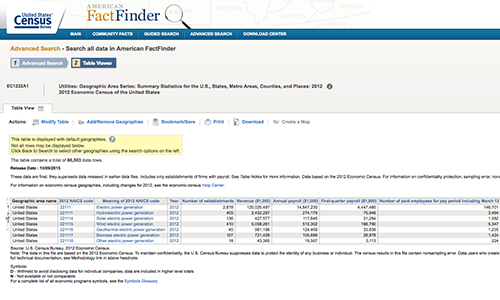April 22, 2016, is Earth Day, and the census has plenty of data you can use to find new business angles for your timely features on sustainable energy.
Here are three ideas for energy business stories you can localize using census-related statistics:
Renewable Energy Industry Revenues
Look at energy data from the 2012 Economic Census (the most recent available) to find revenues, payroll figures, number of employees and more for renewable energy sectors such as hydro, wind, geothermal, biomass and solar that are generating electric power. Or, look at the industry as a whole. Revenues for all these sectors combined total $9.7 billion. That’s up 46.5% from $6.6 billion in 2007 (the last time the Economic Census was conducted). Compare these numbers to the $120 billion in revenue generated by electric power generation companies.
Which Alternate Energy Sources Dominate and Where?
You can use this same data to compare the revenues of different sectors within the renewable energy industry. You’ll see that overall, the wind electric power generation sector had the highest revenue at $5.1 billion, followed by hydro-electric, at $2.4 billion. Click the button to “add/remove geographies” to compare the dominance of these industries in your state or city. Doing so, you’ll find, for instance, that wind power dominates in California, whereas solar electric power generation tops wind electric power in Arizona. Ask companies in your region if there are environmental or regulatory barriers or incentives to other types of renewable energy taking off.
Number of Renewable Energy Establishments Generating Electric Power
Again using this data, look at the column “number of establishments” in each sector and overlay your local geography to see how many such establishments are part of your area’s economy. Or, compare these figures to those from the 2007 Economic Census. The total number of companies (716) has more than doubled from the 312 such businesses tallied in 2007. Ask experts about growth in the renewable energy industry. How do they expect to see these numbers change by 2017?












